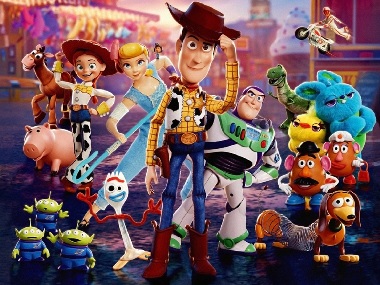One of the tragedies of growing up is realising what you previously thought was alive in fact didn’t really exist. But if you happen to follow the trajectory of Pixar’s path-breaking Toy Story franchise, then you’d know that is not entirely true. First introduced to millions of viewers across the globe in 1995, Toy Story became a benchmark for animation films both in terms of the technology and content. It was the first feature-length film to be entirely computer-animated and it opened up a brave new world where animated films were no longer meant for just kids. [caption id=“attachment_6852171” align=“alignnone” width=“825”] Toy Story 4 poster. Disney[/caption] With the trailer of
Toy Story 4, the toys are not only back but are also far more philosophical — where Woody (Tom Hanks) comes close to leaving the child he was destined to make happy in exchange for a paradise for lost toys. There are many urban legends about how Walt Disney, the father of modern animation, infused subtle messaging in some of the most iconic images that remain etched in the happy memories of millions of children. Images of the death of little Bambi’s mother in front of her eyes, how Dumbo is unable to meet his mother chained for trying to protect him from the bullies, the pipe smoking scene in Peter Pan or the point where Donald Duck nearly kills a cow and Mickey Mouse in Jack and the Beanstalk due to hunger - would all be considered
too dark for films where children are the target audience. More recently, the death of Mufasa in The Lion King, where a young Simba is made to believe that he’s directly responsible for killing his father, stands out too in terms of being the kind of things where even a regular live-action film would find it difficult to get past the censors if the film’s target audience included children. In this aspect, the philosophy of Pixar’s Toy Story series might not be as direct but it is still potent when it comes to messaging. We might not take the antics of a Tom and Jerry or Daffy Duck seriously because they are silly and too ‘cartoony’ but that is not the case with the animated films that Pixar ushered in. The first Pixar production, Toy Story, took place in a world where toys came to life when humans are not present and the high-on-anthropomorphism plot focused on the relationship between an old-fashioned pull-string cowboy doll, Woody, and an astronaut action figure, Buzz Lightyear (Tim Allen). The former feels let down by his owner, Andy, shifting his affections to the latter, who refuses to believe that he is a toy. The highly philosophical narrative had a simple message — unconditional love and selflessness — and only through that can a toy fulfil its purpose and find its happiness. The symbolism in Toy Story’s otherwise ‘dark’ conclusion - ultimately, love could happen only between ‘humans’ and therefore, toys would never be recognised as real people and eventually land up in a garbage dump once children were done with them - is spun around towards the end in an unexpected manner. As Andy is ready to leave for college, his toys would be passed on to his sister, Bonnie, and a dejected Woody overhears Andy’s mother say that she wished she could accompany her son. But when Andy tells her that she has done everything for him, Woody knows it’s time for him to be fully there for Bonnie. While traditionally animation films have always been message-oriented, they started becoming more allegorical with The Lion King in the early 1990s. But it was the first Toy Story film which truly mastered it and now in a little over two-decades, it probably comes a full-circle with the release of Toy Story 4. Carrying on with the tradition of Toy Story 2 and Toy Story 3 where bad toys that were spurned by children like Stinky Pete (Kelsey Grammer) and Lots-o’-Huggin’ Bear (Ned Beatty) decide to go rogue, the latest too has an evil toy as the villain. In Toy Story 4, the nemesis once again is a ‘bad’ toy instead of toy-wrecking bad boys like Sid (Erik von Detten) or even greedy collectors like Al McWhiggin (Wayne Knight). Voiced by Christina Hendricks, Gabby is a pull-string toy form the 1950s sitting in an antique store for ages and it’s in her domain that Woody, while rescuing a runaway toy, Forky (Tony Hale), comes face to face with his old flame Bo Peep (Annie Potts). Gabby has never been loved by a human like Woody or Buzz or the rest of the gang and her ways make Woody question: Toy or otherwise, what is the meaning of existence?
While traditionally animation films have always included messaging, it was Toy Story which first truly mastered it
Advertisement
End of Article


)
)
)
)
)
)
)
)
)



